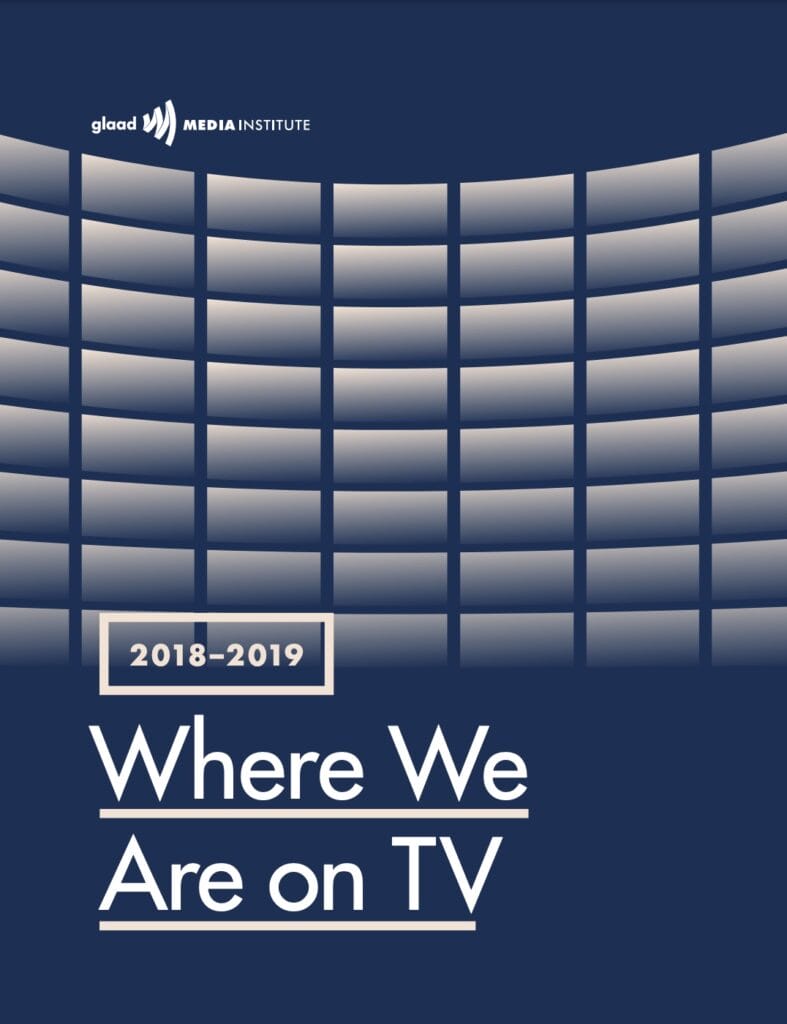The Where We Are on TV report analyzes the overall diversity of primetime scripted series regulars on broadcast networks and looks at the number of LGBTQ characters on cable networks and streaming services for the 2018-2019 TV season.
GLAAD is calling on the industry to make sure that within the next two years, 10 percent of series regular characters on primetime scripted broadcast series are LGBTQ. This is an important next step towards ensuring that our entertainment reflects the world in which it is created.
Below are some of the most remarkable points GLAAD found in its research this year, download the full report now to read more.
- Of the 857 regular characters expected to appear on broadcast scripted primetime programming this season, 75 (8.8%) were identified as gay, lesbian, bisexual, transgender, and/or queer. This is the highest percentage GLAAD has found in the fourteen years this report has counted all broadcast series regulars. There were an additional 38 recurring LGBTQ characters.
- The number of regular LGBTQ characters counted on scripted primetime cable increased to 120, while recurring characters increased to 88, making for 208 characters.
- There were 75 LGBTQ regular characters counted in original scripted series on the streaming services Amazon, Hulu, and Netflix as well as 37 recurring characters, for a total of 112 LGBTQ characters.
- Bisexual+ characters make up 27 percent of the LGBTQ characters tracked across all platforms (broadcast, cable, streaming originals), a slight decrease in percentage from last year, but up to 117 characters from 93 in the previous report. The numbers still skew toward women, though there was an increase in bi+ men this year (84 women to 33 men).
- This year, there are 26 regular and recurring transgender characters tracked across all three platforms, up from 17 last year. Of those, 17 are trans women, five are trans men, and four are non-binary characters.
- Racial diversity of LGBTQ characters is up significantly on all three platforms tracked. For the first time, LGBTQ characters of color outnumber white LGBTQ characters on broadcast television, 50 percent to 49 percent. 44 percent of all series regulars on broadcast scripted television are people of color, a four percent increase from the previous report.
- Last year was GLAAD’s first inclusion of asexual characters in our annual count. Both characters (Raphael Santiago on Freeform’s Shadowhunters, Todd Chavez on Netflix’s BoJack Horseman) have returned from the previous year, but no additional asexual characters have been added. There still no ace characters on broadcast.
- Only 43 percent of the regular characters counted on broadcast primetime television are women, the same percentage as last year and a severe underrepresentation of the U.S. population, which is estimated to be 51 percent women.
- The amount of regular primetime broadcast characters counted who have a disability has slightly increased to 2.1 percent, but that number still vastly underrepresents the actualities of Americans with disabilities. There are seven characters across all three platforms tracked (broadcast, cable, streaming) who are HIV-positive, a substantial increase from last year’s two.
- Netflix counts the highest number of LGBTQ characters on all streaming services and FX counts the highest number on cable networks. The CW boasts the highest percentage of LGBTQ series regular characters of the five broadcast networks.
Accelerate Acceptance
Your gift allows us to track the impact of our work, helping us better understand the state of acceptance and address the gaps with advocacy — like pushing for more trans representation on TV.
About the Where We Are On TV Report
GLAAD’s annual Where We Are On TV report not only propels national conversations about LGBTQ representation, but informs GLAAD’s own advocacy within the television industry. GLAAD uses this yearly data to create a clearer picture of the stories and images being presented by television networks, and to work alongside the networks and content creators to tell fair, accurate, and inclusive LGBTQ stories on screen.
Read about GLAAD’s annual film report, the Studio Responsibility Index, at glaad.org/sri.
Where We Are on TV Archive:
- Where We Are on TV Report: 2022 – 2023 Season
- Where We Are on TV Report: 2021 – 2022 Season
- Where We Are on TV Report: 2020 – 2021 Season
- Where We Are on TV Report: 2019 – 2020 Season
- Where We Are on TV Report: 2018 – 2019 Season
- Where We Are on TV Report: 2017 – 2018 Season
- Where We Are on TV Report: 2016 – 2017 Season
- Where We Are on TV Report: 2015 – 2016 Season
- Where We Are on TV Report: 2014 – 2015 Season
- Where We Are on TV Report: 2013 – 2014 Season
- Where We Are on TV Report: 2012 – 2013 Season
- Where We Are on TV Report: 2011 – 2012 Season
- Where We Are on TV Report: 2010 – 2011 Season
- Where We Are on TV Report: 2009 – 2010 Season
- Where We Are on TV Report: 2008 – 2009 Season
- Where We Are on TV Report: 2007 – 2008 Season
- Where We Are on TV Report: 2006 – 2007 Season













